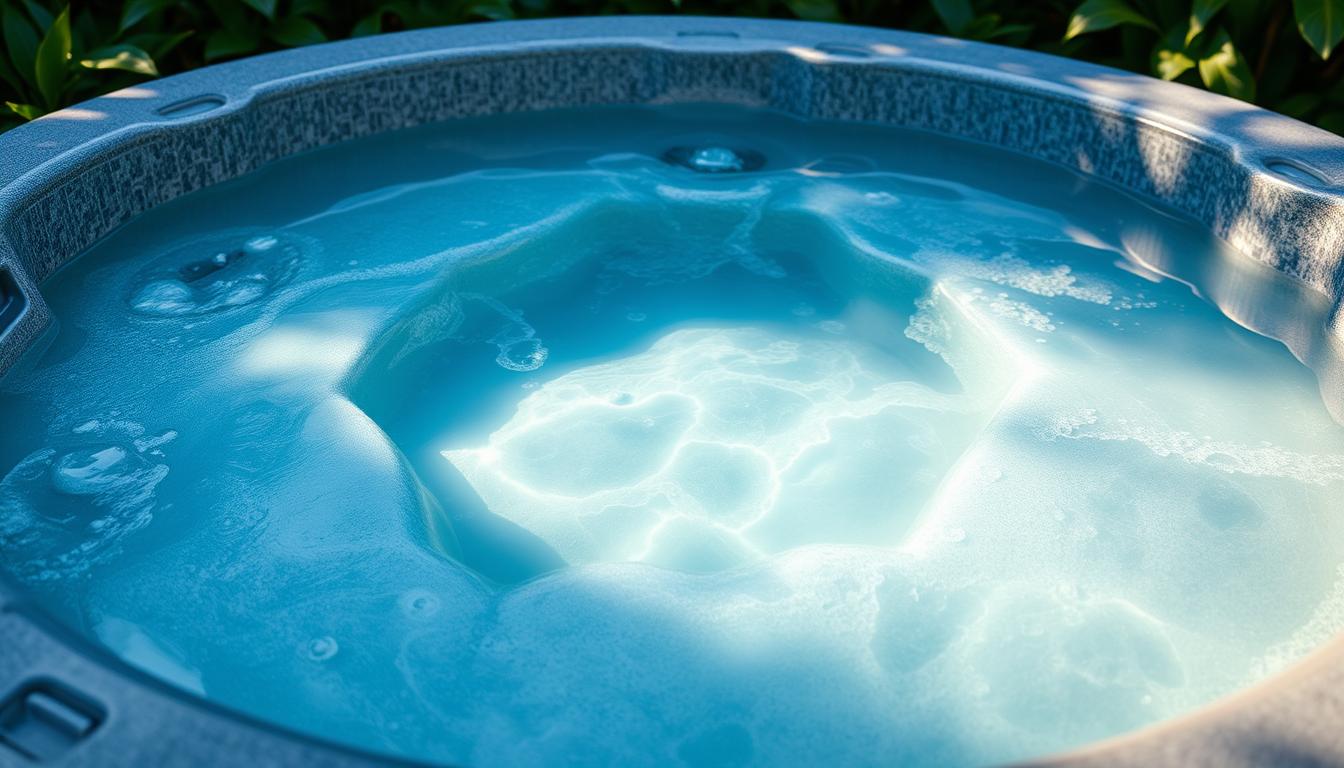
Proper hot tub water chemistry is vital for safe soaking. Maintaining the right alkalinity levels is key. Low alkalinity can cause pH imbalance, corrosion, and skin irritation.
We’ll explore the causes of low alkalinity in hot tubs. We’ll also provide solutions to keep your water in top shape.
Regular water testing is crucial to monitor alkalinity levels. The ideal range is 80 to 120 parts per million (ppm). Low alkalinity can disrupt water chemistry and pose risks.
It can lead to health issues and damage tub components. Quick action is necessary to maintain proper levels.
Key Takeaways
- Low alkalinity in hot tubs can cause pH imbalances, corrosion, and skin irritation.
- Ideal alkalinity range for hot tubs is between 80 and 120 ppm.
- Regular water testing is crucial to monitor alkalinity levels.
- Human factors, environmental influences, and improper chemical use can contribute to low alkalinity.
- Baking soda is a safe and cost-effective solution to raise alkalinity levels in hot tubs.
Understanding Low Alkalinity in Hot Tubs
Balancing total alkalinity in your hot tub is crucial for a safe soak. Low alkalinity can cause corrosion, scale buildup, and skin irritation. Let’s explore total alkalinity, ideal ranges, and its link to pH levels.
What is Total Alkalinity?
Total alkalinity measures alkaline substances in your hot tub water. These include bicarbonates, carbonates, and hydroxides. They act as buffers, stabilizing pH levels and preventing sudden changes.
Ideal Alkalinity Range for Hot Tubs
The ideal total alkalinity for hot tubs is 80-120 parts per million (ppm). This range is important for several reasons. It keeps pH levels stable, preventing skin and eye irritation.
It also stops corrosion of hot tub parts like pumps and heaters. Plus, it reduces scale buildup that can clog pipes and damage equipment.
- It helps keep the pH levels stable, preventing rapid fluctuations that can irritate skin and eyes.
- It prevents corrosion of hot tub components, such as pumps, heaters, and jets.
- It reduces the risk of scale buildup, which can clog pipes and damage equipment.
Test your hot tub water often with a reliable kit. If alkalinity is low, use an alkalinity increaser. The amount needed depends on your tub’s water volume:
| Hot Tub Water Volume (Gallons) | Amount of Alkalinity Increaser (Soda Ash) |
|---|---|
| 200 | 10g |
| 400 | 20g |
| 600 | 30g |
| 800 | 40g |
| 1000 | 50g |
The Relationship Between pH and Alkalinity
pH and alkalinity are linked but measure different things. pH shows water acidity or basicity. Alkalinity is the water’s ability to resist pH changes.
The ideal pH range for hot tubs is 7.2 to 7.8. Low alkalinity can cause rapid pH changes. This makes it hard to keep a stable environment.
Proper hot tub maintenance includes daily testing of pH and sanitizer levels, weekly shock treatments, and monthly cleaning of the hot tub cover to maintain a safe environment.
Understanding total alkalinity and its link to pH is key. Regular testing and adjusting keeps your hot tub clean and comfortable. This ensures your hot tub remains a safe, enjoyable oasis.
What Causes Low Alkalinity in Hot Tub
Low alkalinity in hot tubs can stem from various factors. These include frequent use, environmental influences, and poor maintenance. Understanding these causes helps maintain optimal water chemistry for a safe hot tub experience.
Frequent Hot Tub Usage and Human Factors
Frequent hot tub use often leads to low alkalinity. Pollutants like sweat and body oils alter water chemistry. Chemical residues from swimsuits also contribute to the imbalance.
Proper hygiene before entering the hot tub is crucial. Shower before soaking and wear clean swimsuits. Regular maintenance, including water testing, keeps alkalinity levels within 80-120 ppm.
Environmental Factors and Water Sources
Rainwater and certain water sources can lower alkalinity. Heavy rainfall adds acidic water to your tub. Water lacking essential minerals can decrease total alkalinity levels.
Monitor water chemistry weekly, especially after rain or refilling. Use sodium bicarbonate to increase alkalinity if needed. Follow manufacturer’s instructions for proper dosing.
Improper Chemical Use and Maintenance
Misusing hot tub chemicals can lead to low alkalinity. Chlorine tablets and pH decreasers can throw off water balance. Inconsistent sanitizer levels also affect alkalinity.
| Water Volume (Gallons) | Amount of Soda Ash to Use (Grams) |
|---|---|
| 200 | 10 |
| 400 | 20 |
| 600 | 30 |
| 800 | 40 |
| 1000 | 50 |
Follow manufacturer’s instructions when adding chemicals. Test and adjust water chemistry regularly. Maintain consistent sanitizer levels through proper shock treatments and dosing.
Conclusion
Proper hot tub water chemistry is vital for a safe and enjoyable soak. Low alkalinity can cause pH changes, leading to skin irritation and equipment damage. Aim for an alkalinity range of 80 to 120 ppm and test regularly.
Address low alkalinity by identifying causes like frequent use and environmental factors. Add an alkalinity increaser with sodium carbonate to raise levels. Use 50g per 4,545 litres (1000 gallons) of water.
The amount of soda ash needed depends on your hot tub’s size. For a 200-gallon tub, use 10g. A 1000-gallon tub requires 50g.
Keep pH between 7.2 and 7.8 for a better soak and longer-lasting equipment. Regular testing and adjustments save money and enhance your hot tub experience. Maintain balanced chemistry for crystal-clear water and a relaxing retreat.







